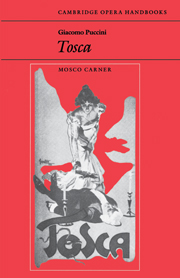Book contents
- Frontmatter
- General preface
- Contents
- List of illustrations
- 1 Sardou and his La Tosca
- 2 Naturalism in opera: verismo
- 3 Genesis of Tosca
- 4 Synopsis
- 5 Play and opera: a comparison
- 6 First production and critical history
- 7 Interpretation: some reflections
- 8 Style and technique
- 9 Musical and dramatic structure
- 10 Analysis: Act I in perspective
- 11 Tosca in the United States
- Notes
- Select bibliography
- Discography by Malcolm Walker
- Index
2 - Naturalism in opera: verismo
Published online by Cambridge University Press: 04 August 2010
- Frontmatter
- General preface
- Contents
- List of illustrations
- 1 Sardou and his La Tosca
- 2 Naturalism in opera: verismo
- 3 Genesis of Tosca
- 4 Synopsis
- 5 Play and opera: a comparison
- 6 First production and critical history
- 7 Interpretation: some reflections
- 8 Style and technique
- 9 Musical and dramatic structure
- 10 Analysis: Act I in perspective
- 11 Tosca in the United States
- Notes
- Select bibliography
- Discography by Malcolm Walker
- Index
Summary
What was it that caused Puccini to revert in the mid-1890s to the Tosca subject, a subject a tinte forti, highly coloured which he had rejected some six years earlier? The answer lies in an important change in the operatic climate during the last few decades of the nineteenth-century, a change that followed the turn in European literature from romanticism to realism and its more extreme form, naturalism. This new realist movement, originating in France, was heralded by such writers as Balzac, Flaubert and Dumas fils, and culminated in Zola, the foremost practitioner and theoretician of naturalism. In opera the first stirrings were sensed in Verdi's Luisa Miller (1849) and notably La Traviata (1853), in which for the first time a sexually tainted heroine was brought on to the operatic stage. Naturalism was firmly placed on the operatic map with Bizet's Carmen (1875) which became a work of seminal importance for naturalist opera of the following decades. Thus, Alfred Bruneau wrote operas after texts drawn from the novels of Zola, Massenet made a single excursion into naturalism with his two-act La Navarraise (1898) and was followed by Charpentier with his Louise (1900). In Italy the chief proponents of operatic naturalism or verismo (from vero = true) was the group of composers known under the collective name, giovanescuola italiana – Mascagni, Leoncavallo, Giordano, and Puccini (Tosca, Madama Butterfly, La fanciulla del west and Il tabarro).
- Type
- Chapter
- Information
- Giacomo Puccini: Tosca , pp. 6 - 10Publisher: Cambridge University PressPrint publication year: 1985



